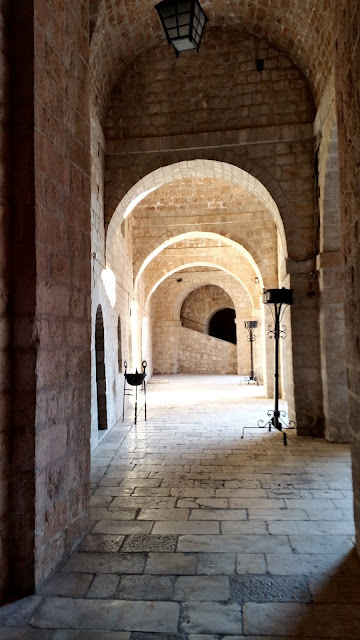Fort
Lovrijenac or St. Lawrence Fortress, often called "Dubrovnik's
Gibraltar", is a fortress and theater outside the western wall of the city;
and at 37 metres above sea level, with walls facing the outside reaching 12
metres thick, the Fort has played an important role in protecting the city over
the ages – in particular during the 11th Century against the
Venetians who tried unsuccessfully to take the city.
The
fortress has been upgraded several times from its construction with major
alterations made in the period of the 15th and 16th century and having suffered
minor damage in the earthquake of 1667, Lovrijenac was also repaired in the late 17th
century.
For centuries, the fort was the greatest defender of the city's freedom, and engraved above its gates is a message for descendents and for the world "Non bene pro toto libertas venditur auro", ("Freedom cannot be sold for all the treasures of the world").
And
now for a brief history lesson …
Historical
lore indicates that Dubrovnik was founded in the 7th century on a rocky island
named Laus, which is said to have provided shelter for refugees from the nearby
Roman city of Epidaurum. The refugees built their new settlement on the small
island of Lausa off the shore while other populations settled along the coast
in the following centuries, directly across the narrow channel, and named their
settlement Dubrovnik. Initially the populations were sceptical of each other,
but over time they grew closer and finally in the 12th century the two
settlements merged. The channel that divided the city was filled creating the
present-day main street (the Stradun) which became the city centre. Thus,
Dubrovnik became the Croatian name for the united town.
Dubrovnik
has suffered two major disasters – a fire which destroyed almost the whole city
in the night of August 16, 1296, and a catastrophic earthquake of 1667 which
killed over 5,000 citizens and levelled most of the public buildings. However
the fort and the wall surrounding the old city have remained almost unscathed
and to this day are testimony to the skills of the labourers and the materials
used in their construction.
The
city has also suffered at the hands of would-be invaders and various rulers down through
the ages – firstly the Ostrogothic Roman Kingdom, then the Byzantine Empire,
followed by the Hungarians and later the Venetians, after which came the Ottoman
Empire - but during most of this time Dubrovnik had achieved relative independence and
self-governance.
In
1806, the city surrendered to the Napoleonic army, as that was the only way to
end a month-long siege by the Russian-Montenegrin fleets (during which 3,000 cannonballs fell on the city). At first,
Napoleon demanded only free passage for his troops, promising not to occupy the
territory and stressing that the French were friends of Dubrovnik. Later, however,
French forces blockaded the harbours, forcing the government to give in and let
French troops enter the city. On this day, all flags and coats of arms above
the city walls were painted black as a sign of mourning. In 1808, Marshal
Auguste de Marmont abolished the republic and integrated its territory first
into Napoleon's Kingdom of Italy and later into the Illyrian provinces under
French rule. This was to last until 28 January 1814 when the city surrendered
to Captain Sir William Hoste leading a body of British and Austrian troops who
were besieging the fortress.
The
city then came under the administration of the Habsburg dynasty until the fall
of Austria–Hungary in 1918 – the city was then incorporated into the new
Kingdom of Serbs, Croats, and Slovenes ( later the Kingdom of Yugoslavia ).
Dubrovnik became one of the 33 oblast of the Kingdom. When in 1929 Yugoslavia
was divided among 9 Banovina, the city became part of the Zeta Banovina, and in 1939 Dubrovnik became part of the newly created Banovina of Croatia.
During
World War II, Dubrovnik became part of the Nazi-puppet Independent State of
Croatia, occupied by the Italian army first, and by the German army after 8
September 1943. In October 1944 Yugoslav Communist Partisans occupied Dubrovnik,
and under communism Dubrovnik became part of the Socialist Republic of Croatia
and Socialist Federal Republic of Yugoslavia.
In
1991 Croatia and Slovenia, which at that time were republics within Socialist
Federal Republic of Yugoslavia, declared their independence and the Socialist
Republic of Croatia was renamed Republic of Croatia.
Following
Croatia's independence in 1991, the Yugoslav People's Army (JNA), by
then composed primarily of Serbs, attacked the city. The siege of Dubrovnik lasted
for seven months. The heaviest artillery attack was on December 6 with 19
people killed and 60 wounded. The number of casualties in the conflict,
according to Croatian Red Cross, was 114 killed civilians.
The
artillery attacks on Dubrovnik damaged 56% of its buildings to some degree, as
the historic walled city, a UNESCO world heritage site, sustained 650 hits by
artillery rounds. The Croatian Army lifted the siege in May 1992, and liberated
Dubrovnik's surroundings by the end of October, but the danger of sudden
attacks by the JNA lasted for another three years.
Following
the end of the war, damage caused by the shelling of the Old Town was repaired, and adhering to UNESCO guidelines, repairs were performed in the original style.
Most of the reconstruction work was done between 1995 and 1999.
The inflicted
damage can be seen on a chart near the city gate, showing all artillery hits
during the siege, and is clearly visible from high points around the city in
the form of the more brightly coloured new roofs. ICTY indictments were issued
for JNA generals and officers involved in the bombing.
City map with the sites of damage caused by the aggression
by the Yugoslav Army, the Serbs and the Montenegrins in 1991-1992
















No comments:
Post a Comment
Note: Only a member of this blog may post a comment.